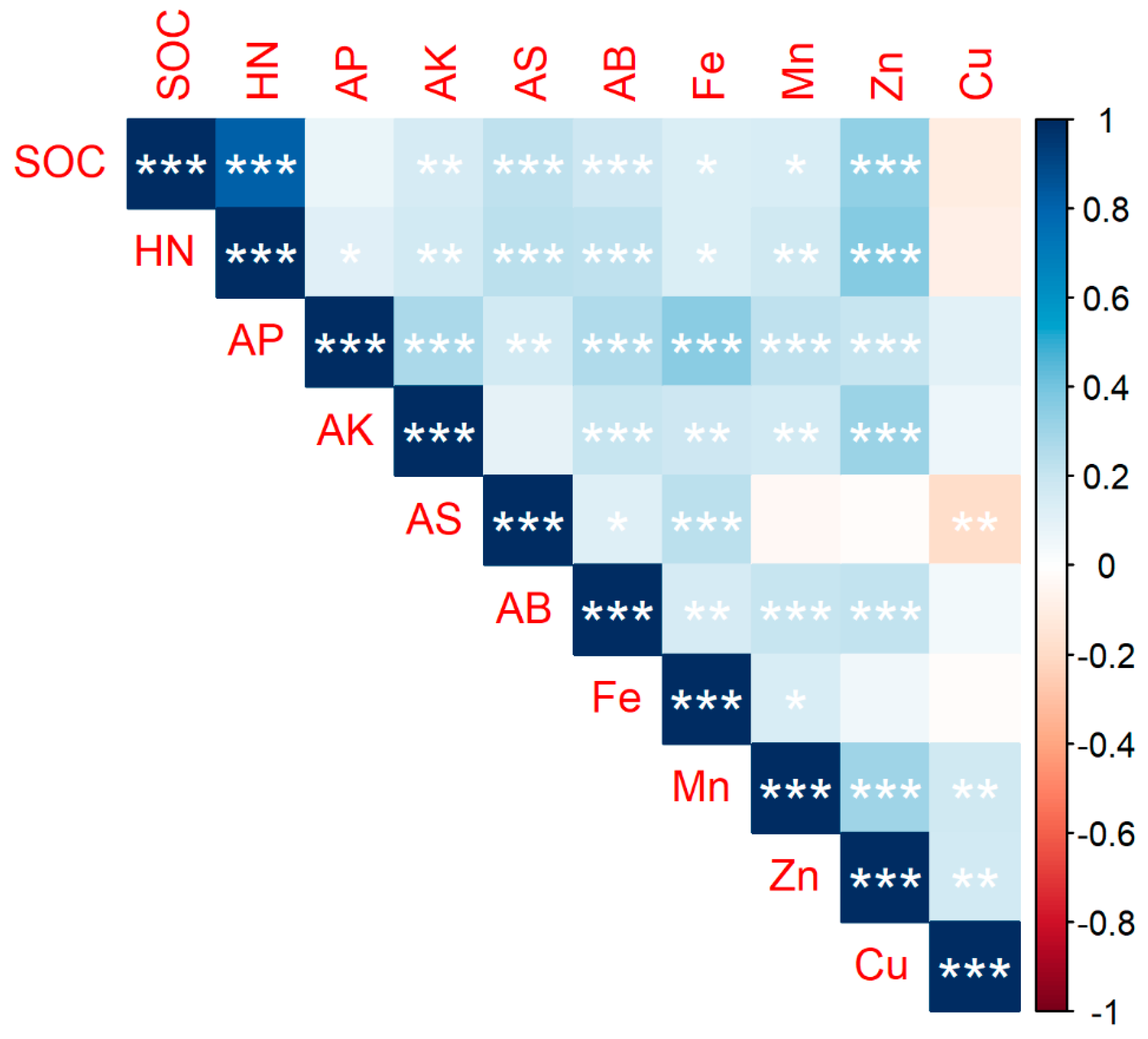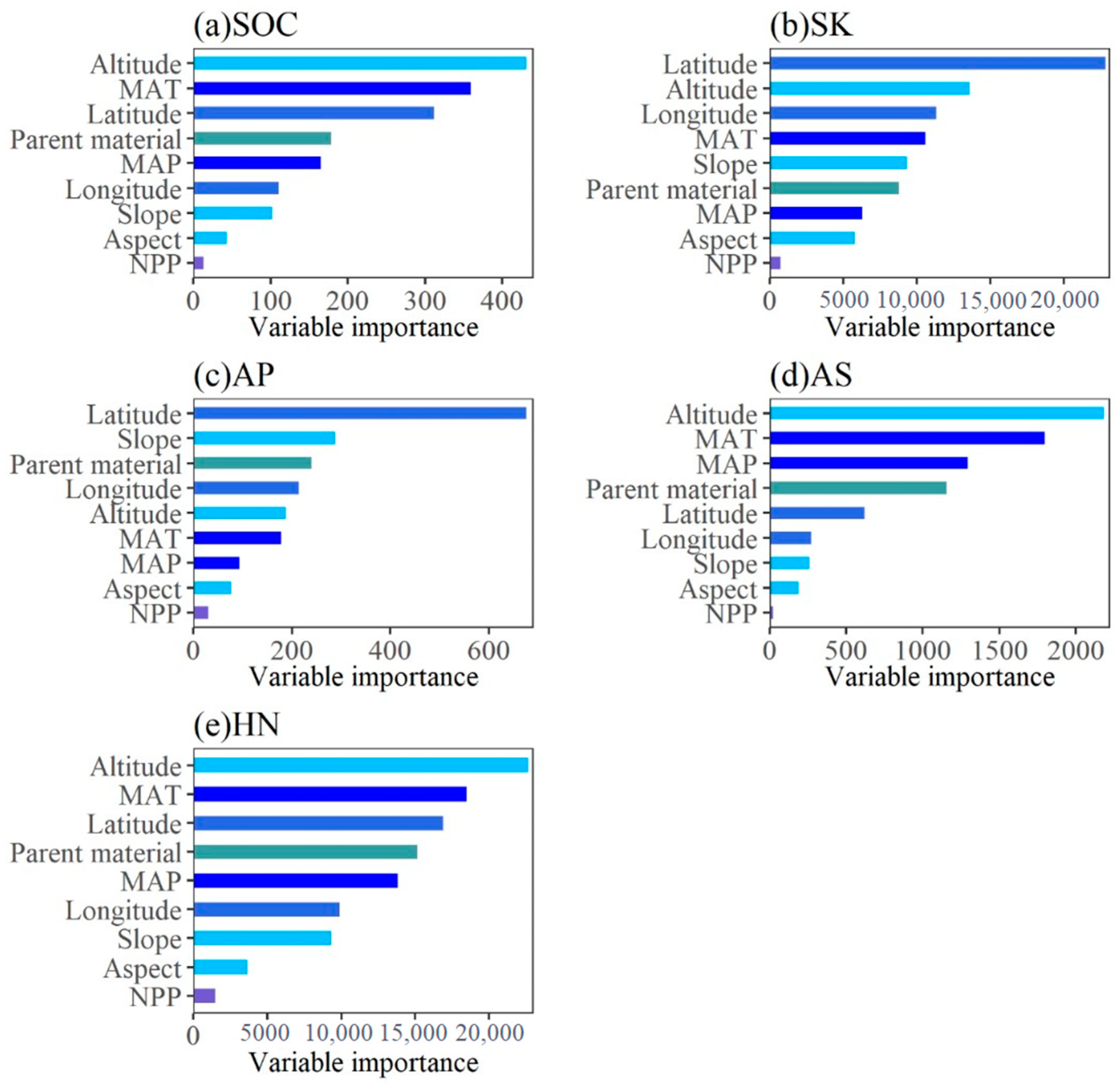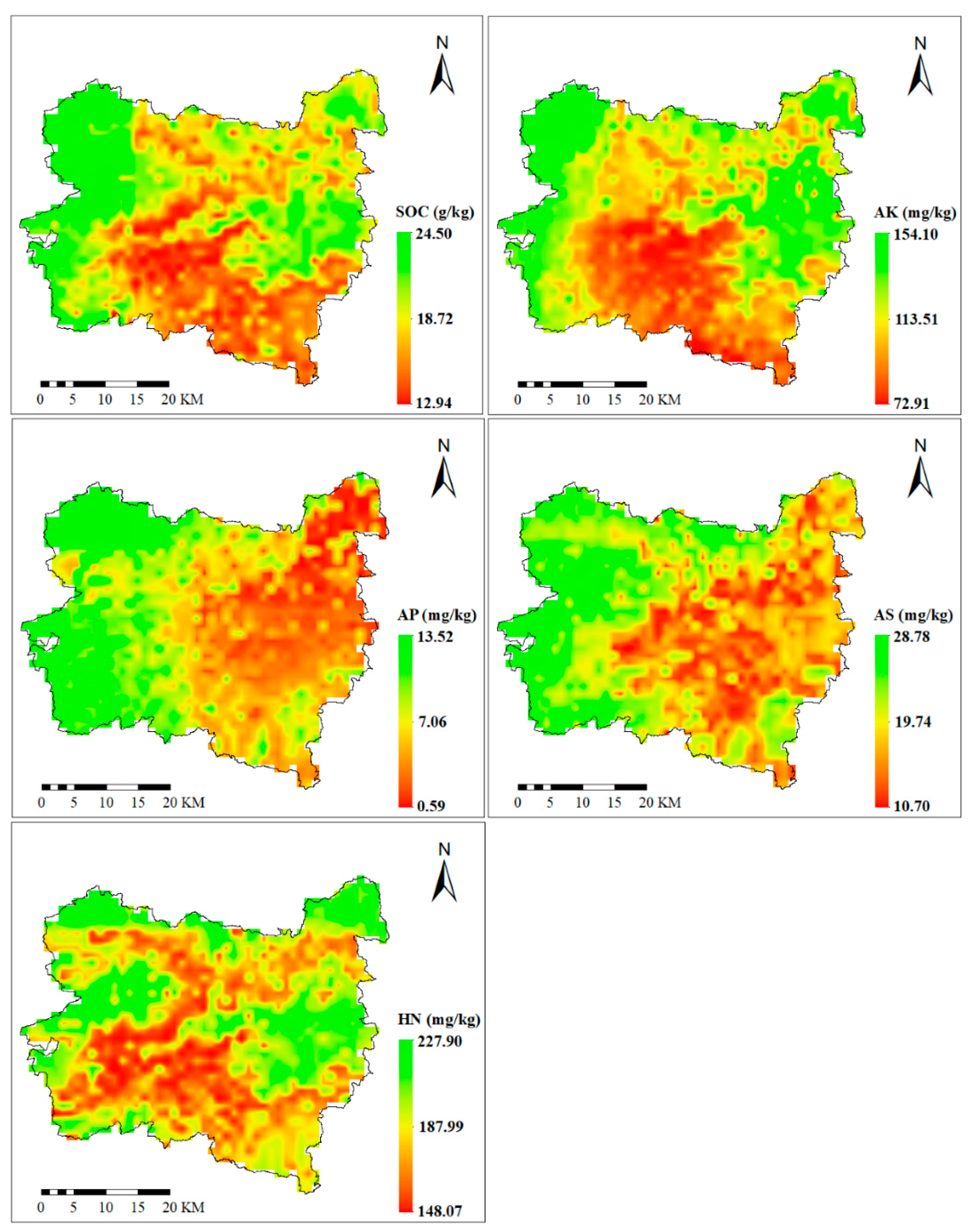Spatial Patterns and Drivers of Soil Chemical Properties in Typical Hickory Plantations
Abstract
:1. Introduction
2. Materials and Methods
2.1. Study Area
2.2. Soil Sampling and Analysis
2.3. Correlation Analysis
2.4. Random Forest Analysis
2.5. Assessment of Predictions
3. Results
3.1. Correlation Analysis of Soil Physicochemical Properties in Hickory Plantation
3.2. Performance and Variable Importance of Random Forest Models for Predicting Soil Nutrients in a Hickory Plantation
3.3. Spatial Pattern of Soil Nutrients in a Hickory Plantation
4. Discussion
4.1. Mean Annual Temperature, Mean Annual Precipitation and Altitude Control the Spatial Distribution of Soil Nutrients
4.2. Effects of Other Factors on Soil Nutrients
5. Conclusions
Supplementary Materials
Author Contributions
Funding
Institutional Review Board Statement
Informed Consent Statement
Data Availability Statement
Conflicts of Interest
References
- Patil, P. Forest Accounting and Ecological Sustainability. Glob. J. Manag. Bus. Res. 2017, 17, 9–16. [Google Scholar]
- Littke, K.; Harrison, R.; Zabowski, D.; Briggs, D.; Maguire, D. Effects of Geoclimatic Factors on Soil Water, Nitrogen, and Foliar Properties of Douglas-Fir Plantations in the Pacific Northwest. Forest Sci. 2014, 60, 1118–1130. [Google Scholar] [CrossRef]
- Grimm, R.; Behrens, T.; Mrker, M.; Elsenbeer, H. Soil organic carbon concentrations and stocks on Barro Colorado Island—Digital soil mapping using Random Forests analysis. Geoderma 2008, 146, 102–113. [Google Scholar] [CrossRef]
- Liu, Z.; Zhou, W.; Shen, J.; He, P.; Lei, Q.; Liang, G. A simple assessment on spatial variability of rice yield and selected soil chemical properties of paddy fields in South China. Geoderma 2014, 235, 39–47. [Google Scholar] [CrossRef]
- Yang, R.; Zhang, G.; Liu, F.; Yang, F.; Lu, Y.; Yang, F.; Li, D.; Yang, M.; Zhao, Y. Comparison of boosted regression tree and random forest models for mapping topsoil organic carbon concentration in an alpine ecosystem. Ecol. Indic. 2016, 60, 870–878. [Google Scholar] [CrossRef]
- Wanshnong, R.; Thakuria, D.; Sangma, C.; Ram, V.; Bora, P. Influence of hill slope on biological pools of carbon, nitrogen, and phosphorus in acidic alfisols of citrus orchard. Catena 2013, 111, 1–8. [Google Scholar] [CrossRef]
- Elbasiouny, H.; Abowaly, M.; Abu_Alkheir, A.; Gad, A. Spatial variation of soil carbon and nitrogen pools by using ordinary Kriging method in an area of north Nile Delta, Egypt. Catena 2014, 113, 70–78. [Google Scholar] [CrossRef]
- Roger, A.; Libohova, Z.; Rossier, N.; Joost, S.; Maltas, A.; Frossard, E.; Sinaj, S. Spatial variability of soil phosphorus in the Fribourg canton, Switzerland. Geoderma 2014, 217, 26–36. [Google Scholar] [CrossRef]
- Xin, Z.B.; Qin, Y.B.; Yu, X.X. Spatial variability in soil organic carbon and its influencing factors in a hilly watershed of the Loess Plateau, China. Catena 2016, 137, 660–669. [Google Scholar] [CrossRef]
- Jenny, H. Factors of Soil Formation: A System of Quantitative Pedology. N. Y. McGraw-Hill 1941, 50, 7. [Google Scholar]
- Wang, S.; Jin, X.; Adhikari, K.; Li, W.; Yu, M.; Bian, Z.; Wang, Q. Mapping total soil nitrogen from a site in northeastern China. Catena 2018, 166, 134–146. [Google Scholar] [CrossRef]
- Saito, H.; Mckenna, S.A.; Zimmerman, D.A.; Coburn, T.C. Geostatistical interpolation of object counts collected from multiple strip transects: Ordinary kriging versus finite domain kriging. Stoch. Environ. Res. Risk Assess. 2005, 19, 71–85. [Google Scholar] [CrossRef]
- Lacoste, M.; Minasny, B.; Mcbratney, A.B.; Michot, D.; Walter, C. High resolution 3D mapping of soil organic carbon in a heterogeneous agricultural landscape. Geoderma 2014, 214, 296–311. [Google Scholar] [CrossRef]
- Tesfahunegn, G.B.; Tamene, L.; Vlek, P.L.G. Catchment-scale spatial variability of soil properties and implications on site-specific soil management in northern Ethiopia. Soil Tillage Res. 2011, 117, 124–139. [Google Scholar] [CrossRef]
- Veronesi, F.; Schillaci, C. Comparison between geostatistical and machine learning models as predictors of topsoil organic carbon with a focus on local uncertainty estimation. Ecol. Indic. 2019, 101, 1032–1044. [Google Scholar] [CrossRef]
- Liaw, A.; Wiener, M. Classification and Regression with RandomForest. R. News 2002, 23, 18–22. [Google Scholar]
- Heung, B.; Bulmer, C.E.; Schmidt, M.G. Predictive soil parent material mapping at a regional-scale: A Random Forest approach. Geoderma 2014, 214, 141–154. [Google Scholar] [CrossRef]
- Zhu, J.; Wu, W.; Liu, H.B. Environmental variables controlling soil organic carbon in top- and sub-soils in karst region of southwestern China. Ecol. Indic. 2018, 90, 624–632. [Google Scholar] [CrossRef]
- Wu, W.F.; Lin, H.P.; Fu, W.J.; Penttinen, P.; Li, Y.F.; Jin, J.; Zhao, K.L.; Wu, J.S. Soil Organic Carbon Content and Microbial Functional Diversity Were Lower in Monospecific Chinese Hickory Stands than in Natural Chinese Hickory–Broad-Leaved Mixed Forests. Forests 2019, 10, 357. [Google Scholar] [CrossRef] [Green Version]
- Shen, Y.F.; Qian, J.F.; Zheng, X.P.; Yuan, Z.Q.; Huang, J.Q.; Wen, G.S.; Wu, J.S. Spatial-temporal variation of soil fertility in chinese walnut (Carya cathay ensis ) plantation. Sci. Silvae Sin. 2016, 52, 1–12. [Google Scholar] [CrossRef]
- Huang, X.Z.; Huang, J.Q.; Chen, D.H.; Lv, J.Q.; Wu, J.S. Comparison on Soil Physical and Chemical Properties at Different Vertical Zones of Carya cathayensis Stands. J. Zhejiang For. Sci. Technol. 2010, 30, 23–27. [Google Scholar]
- Blake, G.R. Particle density. Methods Soil Anal. 2008, 1, 504–505. [Google Scholar]
- Guitian, F.; Carballas, T. Técnicas de Anâlisis de suelos, 2, a ed. Pico Sacro, Santiago de Compostela. 1976. Available online: https://doi.org/10.1097/00010694-197609000-00009 (accessed on 10 February 2022).
- Nelson, D.W. Total carbon, organic carbon, and organic matter. Methods Soil Anal. 1996, 9, 961–1010. [Google Scholar]
- Jackson, M. Soil Chemical Analysis—An Advanced Course; UW-Madison Libraries Parallel Press: Madison, WI, USA, 2005. [Google Scholar]
- Wu, J.S.; Lin, H.P.; Meng, C.F.; Jiang, P.K.; Fu, W.J. Effects of intercropping grasses on soil organic carbon and microbial community functional diversity under Chinese hickory (Carya cathayensis Sarg.) stands. Soil Res. 2014, 52, 575. [Google Scholar] [CrossRef]
- Smith, A.M.; Anderson, G. The relationship between the boron contents of soils and swede roots. J. Sci. Food Agric. 1955, 6, 157–162. [Google Scholar] [CrossRef]
- Agricultural Chemistry Committee of China. Conventional Methods of Soil and Agricultural Chemistry Analysis; Science Press: Beijing, China, 1983. [Google Scholar]
- Null, R.; Team, R.; Null, R.; Writing, T.C.; Null, R.; Team, R.; Null, R.; Core, R.; Team, R.; Team, R. R: A language and environment for statistical computing. Computing 2011, 1, 12–21. [Google Scholar]
- Díaz-Uriarte, R.; Alvarez de Andrés, S. Gene selection and classification of microarray data using random forest. BMC Bioinform. 2006, 7, 3. [Google Scholar] [CrossRef] [PubMed] [Green Version]
- Prasad, A.M.; Iverson, L.R.; Liaw, A. Newer classification and regression tree techniques: Bagging and random forests for ecological prediction. Ecosystems 2006, 9, 181–199. [Google Scholar] [CrossRef]
- Rodriguez-Galiano, V.F.; Ghimire, B.; Rogan, J.; Chica-Olmo, M.; Rigol-Sanchez, J.P. An assessment of the effectiveness of a random forest classifier for land-cover classification. ISPRS J. Photogr. Remote Sens. 2012, 67, 93–104. [Google Scholar] [CrossRef]
- Huang, X.; Cui, C.; Hou, E.; Li, F.; Liu, W.; Jiang, L.; Luo, Y.; Xu, X. Acidification of soil due to forestation at the global scale. For. Ecol. Manag. 2022, 505, 119951. [Google Scholar] [CrossRef]
- Mangla, R.; Kumar, S.; Nandy, S. Random forest regression modelling for forest aboveground biomass estimation using RISAT-1 PolSAR and terrestrial LiDAR data. In Proceedings of the Lidar Remote Sensing for Environmental Monitoring XV, New Delhi, India, 8 December 2016. [Google Scholar]
- ESRI. What is ArcGIS? 2002. Available online: http://bases.bireme.br/cgi-bin/wxislind.exe/iah/online/?IsisScript=iah/iah.xis&src=google&base=REPIDISCA&lang=p&nextAction=lnk&exprSearch=35663&indexSearch=ID (accessed on 10 February 2022).
- Neff, J.C.; Hooper, D.U. Vegetation and climate controls on potential CO2, DOC and DON production in northern latitude soils. Glob. Change Biol. 2002, 8, 872–884. [Google Scholar] [CrossRef]
- Foroughifar, H.; Jafarzadeh, A.A.; Torabi, H.; Pakpour, A.; Miransari, M. Using Geostatistics and Geographic Information System Techniques to Characterize Spatial Variability of Soil Properties, Including Micronutrients. Commun. Soil Sci. Plant Anal. 2013, 44, 1273–1281. [Google Scholar] [CrossRef]
- Zhang, Z.M.; Zhou, Y.C.; Wang, S.J.; Huang, X.F. The soil organic carbon stock and its influencing factors in a mountainous karst basin in P. R. China. Carbonates Evaporites 2018, 34, 1031–1043. [Google Scholar] [CrossRef]
- Yang, Y.H.; Fang, J.Y.; Wenhong, M.A.; Smith, P.; Wang, W. Soil carbon stock and its changes in northern China’s grasslands from 1980s to 2000s. Glob. Change Biol. 2010, 16, 3036–3047. [Google Scholar] [CrossRef]
- Hobley, E.; Wilson, B.; Wilkie, A.; Gray, J.; Koen, T. Drivers of soil organic carbon storage and vertical distribution in Eastern Australia. Plant Soil 2015, 390, 111–127. [Google Scholar] [CrossRef]
- Choudhury, B.U.; Fiyaz, A.R.; Mohapatra, K.P.; Ngachan, S. Impact of Land Uses, Agrophysical Variables and Altitudinal Gradient on Soil Organic Carbon Concentration of North-Eastern Himalayan Region of India. Land Degrad. Dev. 2016, 27, 1163–1174. [Google Scholar] [CrossRef]
- Tsozué, D.; Nghonda, J.P.; Tematio, P.; Basga, S.D. Changes in soil properties and soil organic carbon stocks along an elevation gradient at Mount Bambouto, Central Africa. Catena 2019, 175, 251–262. [Google Scholar] [CrossRef]
- Huang, M.T.; Piao, S.L.; Ciais, P.; Peñuelas, J.; Wang, X.H.; Keenan, T.F.; Peng, S.S.; Berry, J.A.; Wang, K.; Mao, J.F.; et al. Air temperature optima of vegetation productivity across global biomes. Nat. Ecol. Evol. 2019, 3, 772–779. [Google Scholar] [CrossRef] [PubMed]
- Eamus, D. How does ecosystem water balance affect net primary productivity of woody ecosystems? Funct. Plant Biol. 2003, 30, 187–205. [Google Scholar] [CrossRef] [PubMed]
- Sinoga, J.D.R.; Pariente, S.; Diaz, A.R.; Murillo, J.F.M. Variability of relationships between soil organic carbon and some soil properties in Mediterranean rangelands under different climatic conditions (South of Spain). Catena 2012, 94, 17–25. [Google Scholar] [CrossRef]
- Johnson, C.E.; Ruiz-Mendez, J.J.; Lawrence, G.B. Forest Soil Chemistry and Terrain Attributes in a Catskills Watershed. Soil Sci. Soc. Am. J. 2000, 64, 1804–1814. [Google Scholar] [CrossRef]
- Wang, H.J.; Shi, X.Z.; Yu, D.S.; Weindorf, D.C.; Huang, B.; Sun, W.X.; Ritsema, C.J.; Milne, E. Factors determining soil nutrient distribution in a small-scaled watershed in the purple soil region of Sichuan Province, China. Soil Tillage Res. 2009, 105, 300–306. [Google Scholar] [CrossRef]
- Florinsky, I.V. Digital Terrain Analysis in Soil Science and Geology, 2nd ed.; Academic Press: Cambridge, MA, USA, 2016; pp. 377–385. [Google Scholar]






| Soil Properties | R2oob | RMSEoob | MAEoob |
|---|---|---|---|
| SOC | 0.67 | 1.66 | 1.02 |
| SK | 0.69 | 10.42 | 7.92 |
| HN | 0.60 | 11.30 | 8.65 |
| AP | 0.29 | 1.57 | 0.98 |
| AS | 0.43 | 4.62 | 2.36 |
| AB | 0.63 | 0.10 | 0.07 |
| Fe | 0.67 | 2.54 | 1.78 |
| Mn | 0.77 | 4.49 | 3.64 |
| Zn | 0.51 | 0.15 | 0.11 |
| Cu | 0.79 | 0.15 | 0.12 |
Publisher’s Note: MDPI stays neutral with regard to jurisdictional claims in published maps and institutional affiliations. |
© 2022 by the authors. Licensee MDPI, Basel, Switzerland. This article is an open access article distributed under the terms and conditions of the Creative Commons Attribution (CC BY) license (https://creativecommons.org/licenses/by/4.0/).
Share and Cite
Sun, M.; Hou, E.; Wu, J.; Huang, J.; Huang, X.; Xu, X. Spatial Patterns and Drivers of Soil Chemical Properties in Typical Hickory Plantations. Forests 2022, 13, 457. https://doi.org/10.3390/f13030457
Sun M, Hou E, Wu J, Huang J, Huang X, Xu X. Spatial Patterns and Drivers of Soil Chemical Properties in Typical Hickory Plantations. Forests. 2022; 13(3):457. https://doi.org/10.3390/f13030457
Chicago/Turabian StyleSun, Mengjiao, Enqing Hou, Jiasen Wu, Jianqin Huang, Xingzhao Huang, and Xiaoniu Xu. 2022. "Spatial Patterns and Drivers of Soil Chemical Properties in Typical Hickory Plantations" Forests 13, no. 3: 457. https://doi.org/10.3390/f13030457
APA StyleSun, M., Hou, E., Wu, J., Huang, J., Huang, X., & Xu, X. (2022). Spatial Patterns and Drivers of Soil Chemical Properties in Typical Hickory Plantations. Forests, 13(3), 457. https://doi.org/10.3390/f13030457






